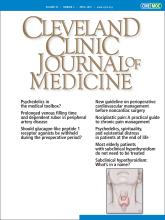
“Remember what the dormouse said, feed your head…”*
In this issue of the Journal, Cornish et al1 discuss the potential therapeutic role of psychedelics in the care of patients at the end of life. This follows a previous paper2 in the Journal in which a different group of authors discussed the use of psychedelics as an adjunctive component of psychotherapy in the treatment of various psychiatric conditions and substance use disorders. Given the historical association of psychedelics, including lysergic acid diethylamide (LSD), psilocybin, and mescaline, as “recreational” mind-altering, and possibly creativity-enhancing, compounds within countercultures of the 1960s and 1970s, their current introduction into several aspects of medical practice is a surprise to many. It may be even more of a surprise to those who recall news reports of “bad trips” linked to violent crimes or suicides in the past.
As I understand the rationale for psychedelics as a component of end-of-life care,1 they have the potential to provide some relief to patients suffering from “existential distress.” This distress can accompany a patient’s confrontation with the immediacy of their mortality. Psychedelics may ease a patient’s distress by providing an alternative coping and understanding pathway, using enhanced connectivity through vivid imagery reflecting their own thoughts as well as amplified responsiveness and interactions with persons around them. This seems consistent with experiences described by proponents of psychedelic use in the 1960s—that psychedelics can enhance introspection and promote a perception of oneness with a “true” reality, a component of enlightenment. The use of “mind-altering” chemicals or dramatic self-imposed physical interventions (eg, fasting, lodge sweating, sleep deprivation, meditation) in efforts to achieve a higher state of awareness and personal understanding has been a practice incorporated by many cultures and religions for centuries.
There are also some data demonstrating prolonged analgesic effects of LSD, comparable and, in some cases, superior to narcotics. But given the proclivity of many of us to passively ignore or actively deny our mortality throughout most of our lives, the use of psychedelics to dramatically confront and resolve our end-of-life issues may not be a good fit for everyone. The example case scenario in Cornish et al1 presented a social worker (an occupation steeped in the need to confront emotional challenges head-on) who had previously self-experimented with psychedelics (thus likely eliminating the fear of the drug experience) is likely a better candidate than many for this therapeutic approach. There is recognition of the need in psychedelic-assisted therapy for the appropriate “set” (personal mindset) and environmental “setting” to increase the likelihood of therapeutic success, factors that can also complicate clinical trial design and interpretation.
Using the “mind-expanding” and sensory- and interaction-intensifying properties of psychedelics in this way fits with the personal use of these drugs in the 1960s and 1970s. Under controlled circumstances, I can see how their use can potentially facilitate the successful psychotherapeutic relationship2—providing the ability to engage with personal (and interpersonal) realities in a different and possibly enhanced manner. Assuming of course that the experience can be constrained within physically and emotionally safe environs, there may be accelerated therapeutic confrontation with deep-seated (“repressed”) triggers for anxiety, depression, stress disorders, and on. But interestingly, the early use of psychedelics by psychiatrists was for a different intent.3
In the early 1900s, in part driven by stories from social anthropologists studying psychedelic use and consciousness-altering practices of various religious and cultural traditions, academic psychiatrists began to study the naturally occurring and later chemically synthesized psychedelics (LSD was synthesized by Albert Hoffman while working at Sandoz laboratories circa 1938). Experimentalists hoped to mimic defined psychiatric illnesses like schizophrenia by administering mescaline and other psychedelics to themselves and to healthy volunteers. Their goal was to mimic psychoses and thus support the concept of a biological basis for psychiatric illness, elevating the field of academic psychiatry to a level on par with the other scientifically advancing fields of medicine. Competing with these efforts was the work of Freud and other psychoanalysts.
There were several papers published detailing the biological, emotional, and cognitive effects of exposure to peyote, mescaline, and LSD. Synthesizing these data and the results of his own studies, British psychiatrist GT Stockings proposed that endogenous neurochemicals similar to mescaline were responsible for psychoses.4 Experimentation with LSD continued through the 1960s, including studies attempting to relieve the psychological effects of war trauma by using psychedelics to have patients intensively relive their traumas in a controlled environment. Investigations of LSD continued until Sandoz Pharmaceuticals withdrew distribution of the compound, apparently in response to negative social pressures and rigid new restrictions on human drug experimentation enforced by the US Food and Drug Administration.
The biological basis for some psychiatric diseases was fully recognized when the Nobel Prize for Physiology or Medicine in 2000 was awarded to Arvid Carlsson for his discoveries concerning neurotransmitters, including his work elucidating the role of dopamine in the clinical expression of schizophrenia.
Footnotes
↵* Grace Slick. “White Rabbit.” On Jefferson Airplane recording Surrealistic Pillow. Originally released in 1967.
- Copyright © 2025 The Cleveland Clinic Foundation. All Rights Reserved.






